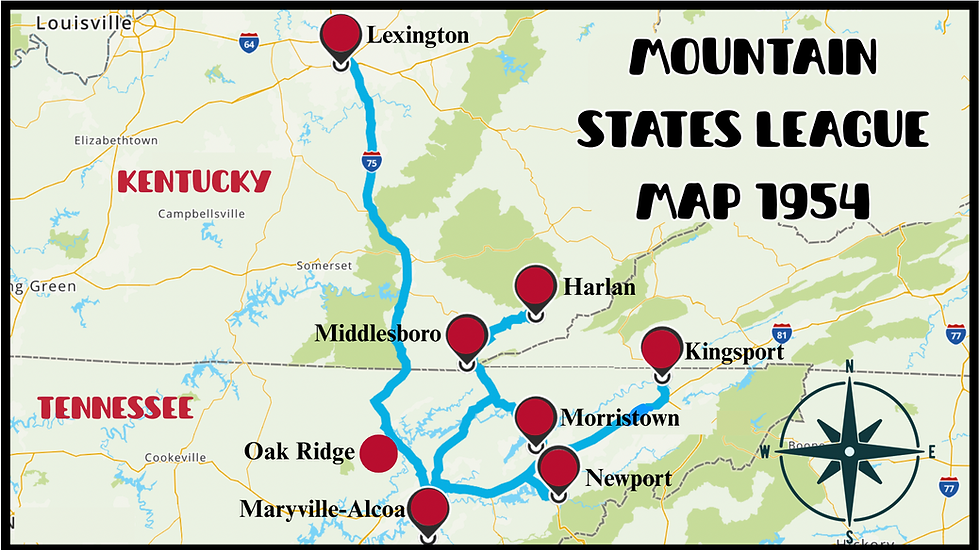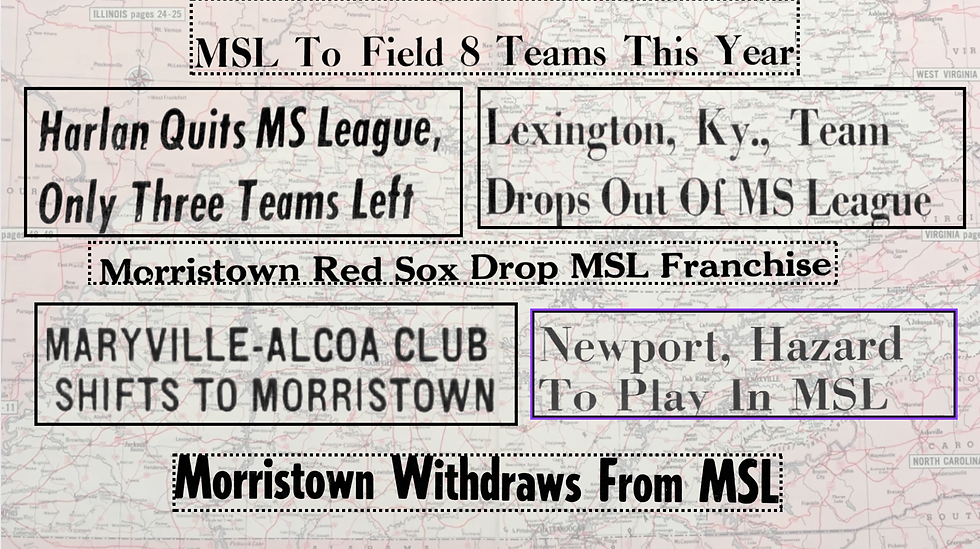The Year of Unravel: A Look Back at the Mountain States League in 1954
- Marc Viquez

- Sep 5
- 7 min read
Updated: Sep 9

If there was a case study in league failure, the Mountain States League might be the perfect example. What started as an 8-team league in April of 1954 dwindled to three clubs less than three months later. Teams disappeared without much notice, and clubs threw in the towel one after the other.
The league was organized in 1948, during the post-war boom in minor league baseball, with six teams. Virgil Q. Wacks, an energetic and successful promoter, served as the loop’s president. It operated with minimal change for most of its first seven seasons, with only four teams folding. However, when the 1954 season began, three new clubs were added to challenge its stability.
Wacks sought to expand to 10 teams in 1953 and aimed to compel Major League Baseball to pay for TV broadcasts in the league's territory. Attendance that year, however, fell to 764 fans per game, the lowest among 8-team circuits. However, there were cracks this year that should have been a harbinger of things to come for the league.
To spark renewed interest, the league considered splitting the season into two halves, and clubs organized special promotional nights for teachers, farmers, and lawyers. “Cash and Carry Nights,” where one lucky fan could haul away as many nickels, quarters, and dimes as they could carry, became a hit, while “Jackpot Night” handed out a $1,000 bill to a fortunate attendee.
Then there were the Knoxville Smokies, where owner Byron Kitchen hoped to have enough money to make it to opening day. The club was forced to play outside of town while a new municipal stadium was being constructed, saw low attendance figures, forfeited a game due to a lack of balls, and almost transferred operations to Hazard in May. However, Wacks was confident as the league prepared for its seventh season.
“The fans will see the best baseball this season that has ever been produced in the Mountain States League.”
The league announced 8 teams would start the season on March 24: the Morristown Red Sox, Newport Canners, Hazard Bombers, Maryville-Alcoa Twins, Middlesboro A’s, Harlan Smokies, Kingsport Cherokees, and the Oak Ridge Pioneers. Newport and Hazard had both rejoined the league together on March 15, 1954.
Sports columnist Tom Anderson of the Knoxville Journal wrote that “it would be a tribute to Wacks if he makes it through the season.” However, not even Wacks could foresee what would happen; in an era where there were many examples of league instability, the Mountain States League set the standard.

The Morristown Gazette Mail promoted Newport Canners as the visiting team for the home opener.
The first red flag was the Bombers dropping out of the league around April 1, leading Wacks to scramble to find a new team in Lexington, which was well over 100 miles from the nearest club. There was no official wording on why Hazard dropped out so suddenly, but the team had left the league after its 1952 pennant due to being in considerable debt.
Newport was set to play at the new Nease Stadium for free. Local businesses collected around $10,000 to ensure operations for the season. The Canners had played in the league from 1948 to 1950 before relocating to Norton, Virginia.
The closest Newport came to playing was an ad in the Morristown Gazette Mail for the home opener at Sherwood Park on April 24. Around this time, reports emerged of shaky financial ground. If Newport couldn't play, Wacks said Hazard would be reinstated as the 8th club. It was later reported that Newport couldn’t raise enough money to fix up its ballpark or pay its players.
The Mountain States League became the only 7-team league in the country, with one team having to sit idle for the first two weeks of the season. It would affect the Morristown Red Sox, who lost $5,800 in 1953 and $25,000 during the first month of the current season. The Sox played only 7 home dates during their first three weeks, taking in $500, while paying out $3,000.

With another year of running in the red, team president Fred Hartman withdrew his franchise on May 17. Morristown would eventually get another franchise the following month when our next team ran into financial troubles in their original market.
Kingsport owners Sam Bray made national headlines on June 6 when he announced that he would give away his club, lock, stock, and barrel, plus $3,000 in cash, to anyone willing to operate the club for the rest of the year in town. The deal included team uniforms, equipment, team bus, players' contracts, concession stand stock, and being debt-free.
The Maryville-Alcoa Twins entered the league in 1953 and played out of Hunt Field, 9 miles away from the Knoxville Smokies (Class B) brand-new $600,000 Municipal Stadium in 1954. The proximity to the Smokies hindered attendance; a May 12 game drew only 68 people to the stands.
The Twins ceased operations on June 14 due to an $8,000 tax bill from the previous season, which required a $2,000 upfront payment to the federal government. The club then announced it would relocate to Morristown, but as quickly as the story made print, it was announced that the team was saved by its parent club, Cincinnati, and would temporarily remain at Hunt Field.
After failing to secure additional funding, the Twins relocated to Morristown and renamed the Reds on June 20. Their stay was brief, lasting only 10 days. Cincinnati liked Morristown as a minor league city, but felt team quality and financial losses were prohibitive for continuing the season.
The next team on the chopping block was the Lexington Colts, who had just joined 17 days before the season opener to replace the Hazard franchise that never got off the ground. Although the Colts had financial trouble of their own, they were committed to completing the season; their official demise was due to an odd league rule.
When the Morristown Reds franchise folded, other clubs forced Lexington to fold to balance the schedule and reduce travel expenses. On July 6, Lexington was notified that it was no longer in the league, based on a rule that states if there is an odd number of teams, the newest member will cease operations.

With four teams left in the league, Wacks was determined to finish the season with a new schedule, and the remaining clubs would start from scratch with a new set of standings. The last day of the season would be set for August 15, when a pennant winner would be announced.
That would not take place when the Harlan Smokies, who exhausted their operating funds for the season, gave up the ghost on July 19. Smokies president Dr. Willard Buttermore said at the time of withdrawal that the club was “unable to make it financially.” The club had played to 10,000 people, with about 250-300 in attendance per game.
A last-ditch effort was made to replace the Smokies with a semi-pro team from Pennington Gap from the Lonesome Pine League to complete the season. Wacks hoped to send the team to Kingsport, but that never materialized. Without any other options, the Mountain States League ceased operations on July 20.

Kingsport, Middlesboro, and Oak Ridge were the last three teams remaining, each facing financial challenges. Of these, Middlesboro may have been the only franchise in stable financial condition. To cover the $13,000 renovation costs of Ridgewood Park, Oak Ridge had earlier offered $10 shares to the public. After league play ended, the Pioneers transitioned to a semi-pro club and continued to compete against teams within a 50-mile radius until August.
Meanwhile, Kingsport's owner, Sam Bray, had turned fortunes around on the season, having his family operate the team for free and having players wash and mend their own uniforms. He sold off many of his players to other clubs, and the ones that were released were paid before they left to go home for the season.
“Maybe I’ll go with them, because most of them are from Cuba and I could stand a vacation.”
Wacks once said that the MSL was “steady as a rock,” vowed to return with an 8-team league for the 1955 season. The three remaining clubs would return, along with commitments from five other cities and towns on the league map. He was optimistic and ready to do the groundwork, but was sensibly advised to reconsider in March.
“I had eight towns tentatively lined up for the league this season. I feel certain we could have operated, but after discussing it with an associate, we decided it would be better to take a break for a season or two. After going without professional baseball for a season or so, the fans will be hungry for the sport.”
Wacks did try a few more times, even as late as 1969, to reform the league as a Class A loop. He said that he had several contacts in former towns and even looked into new markets for his proposed league. It never happened, but he was busy hosting The Virgil Q. Wacks Varieties Show,” which ran on local television from 1957 to 1983. He also served as a sportscaster and radio announcer for many years before he died in 1994.
Perhaps one Marsh Town said it best in his daily column in The Morristown Sun on July 17, 1953, when he wrote
"VIrgil Q. Wacks must spend some sleepless nights trying to figure out how to hold the league together."
The Mountain States League left an interesting footnote in the annals of minor league baseball after the war. Just because you can place teams anywhere doesn’t mean you have a league. This lesson has been repeated many times since the league’s closure over 70 years ago and will likely be repeated.
Name | Date | Results |
Newport Canners | April 25, 1954 | Not enough money to operate for the season; never played a game. |
Morristown Red Sox | May 15, 1954 | Folded due to uneven teams and low gate receipts |
Maryville-Alcoa Twins | June 19, 1954 | Relocated to Middletown and renamed Reds. |
Morristown Reds | July 1, 1954 | Cincinnati pulled the club out due to differences with the league. |
Lexington Colts | July 7, 1954 | Expelled from the league due to the number of teams and the date joined. |
Harlan Smokes | July 19, 1954 | Ran out of money for the season |
Mountain States League | July 20, 1954 | League ceased operations; only Kingsport, Middletown, and Oak Ridge remained. |
——–
Follow all of Marc’s stadium journeys on Twitter @ballparkhunter and his YouTube channel.







Comments